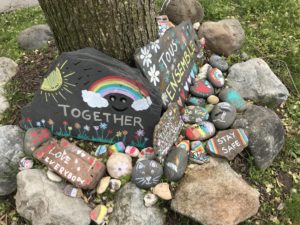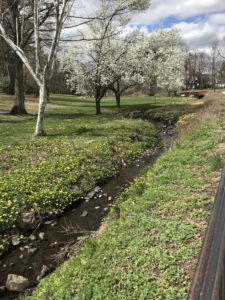 We are living together while we are living apart. Though trapped in separate cells, we have never been more aware of how interlaced are our lives, air, bodies, hands, breath. We are both far too alone, and not nearly isolated enough.
We are living together while we are living apart. Though trapped in separate cells, we have never been more aware of how interlaced are our lives, air, bodies, hands, breath. We are both far too alone, and not nearly isolated enough.
We feel urgency to establish communities. Is a Zoom screen of tiny faces in boxes really a community? Can my neighborhood, my workplace, my organization, function as a community with its members forced apart? When most people think of ‘community,’ they imagine a vaguely mythic, harmonious, organic village, but that idea was invented in the 19th century as an antidote to industrialized, urban modernity. ‘Community,’ points out Zygmunt Bauman, is always a good word; it carries idealizing qualities that ‘company’ and ‘society’ do not (1).
But real communities consist of people sustaining relationships with each other, with all the messiness that that entails, and the ‘living’ often occurs at a distance. The virtual groups we have cobbled together in coronavirus time are real communities. People live in “personal networks,” small, fairly stable groups of close friends and relations, averaging about 18 people (see Pahl, 635; Fischer, 38; Spencer and Pahl, 46). These participants need not share a geographic space. “Postmodern communities are nomadic, highly mobile, emotional and communicative,” explains Gerard Delanty (157). My favorite article on this topic has the memorable title,“Are all communities communities in the mind?” Perhaps even when people live in the same locale, we carry our relationships in our minds and our hearts.
So: your teammates, your classmates, your club members, your siblings, your family, your alumni group, your knitting circle, your colleagues, your neighbors, your religious-institution friends: they are communities. Most people do not live in nuclear families. But even when they do, they reach out to others like them. For these personal networks, these chosen families, constitute a major survival mechanism for our species – they predate the hegemonic nuclear family and extend beyond it. Our virtual communities are real and necessary, and we should not see them as stand-ins for some other, more real, in-person family configuration, or substitutes for some kind of golden-age village.
Indeed, I’d say that community members do not need to be human, or even sentient. All that matters is that they meet your need. They can be songs from your youth, soft ancient sweatshirts, great poems, immersive films, high-quality chocolate, affectionate pets, yoga routines, rocks warmed in the sun. If they offer you the feelings you need right now, they are giving you care, and if you are engaging with them and appreciating them, you are caring back again. It is entirely possible, although maybe not emotionally ideal, to create a community whose other members consist of music.
In a community with other humans, it is helpful to remember two principles. First, within the community, everyone ought to feel equally valued, regardless of their status in the outside world. Second, viable communities have conversations that shift fluidly among different people’s needs as members reassure and comfort each other, explain and resolve problems. Egalitarianism and fluidity: everyone is valued, everyone’s needs must be heard and met, as if we are all balanced in a web, and one person tugging on a filament attracts everyone’s attention, and another person can spin a countervailing support.
 Being a good member of a community does not mean being a star. It might, rather, mean having an effect that is “incalculably diffusive: for the growing good of the world is partly dependent on unhistoric acts; and that things are not so ill with you and me as they might have been, is half owing to the number who lived faithfully a hidden life, and rest in unvisited tombs” (785). George Eliot compares Dorothea’s influence to rivulets soaking into the earth, diffusely fertilizing the soil. Our communities are not necessarily full of famous people, or brilliant people, or the people we were born to. They are the members that we have chosen. They are the people – or the art, or the growing plants – we keep choosing, day after day. All that online life: those diffuse rivulets enrich our soil, those data threads reaching across the distance to weave a communal web. In coronavirus spring, we are seeing, at last, that the “hidden life” is the real life we all already live.
Being a good member of a community does not mean being a star. It might, rather, mean having an effect that is “incalculably diffusive: for the growing good of the world is partly dependent on unhistoric acts; and that things are not so ill with you and me as they might have been, is half owing to the number who lived faithfully a hidden life, and rest in unvisited tombs” (785). George Eliot compares Dorothea’s influence to rivulets soaking into the earth, diffusely fertilizing the soil. Our communities are not necessarily full of famous people, or brilliant people, or the people we were born to. They are the members that we have chosen. They are the people – or the art, or the growing plants – we keep choosing, day after day. All that online life: those diffuse rivulets enrich our soil, those data threads reaching across the distance to weave a communal web. In coronavirus spring, we are seeing, at last, that the “hidden life” is the real life we all already live.
Sources used here:
Zygmunt Bauman, Community: Seeking Safety in an Insecure World (Cambridge UK: Polity, 2001)
Gerard Delanty, Community (London and NY: Routledge, 2018, 3rd ed.)
George Eliot, Middlemarch, ed. David Carroll (Oxford World’s Classics, 1996, first ed. 1871-1872)
Claude S. Fischer, To Dwell Among Friends (Chicago: Chicago UP 1982)
Ray Pahl, “Are all communities communities in the mind?” The Sociological Review 53:4 (Nov 2005), 621-640
Liz Spencer and Ray Pahl, Rethinking Friendship: Hidden Solidarities Today (Princeton: Princeton UP, 2006)
Read more about community:
Kenneth C. Bessant, The Relational Fabric of Community (NY: Palgrave Macmillan, 2018)
Karma Chavez, Queer Migration Politics: Activist Rhetoric and Coalitional Possibilities (U Illinois Press, 2013)
Danielle Sered, Until We Reckon: Violence, Mass Incarceration, and a Road to Repair (The New Press, 2019)

